David Mearns - Search Director, The Finding Sydney Foundation
Knowing it was unlikely that such unique deeptow side-scan sonar equipment would ever again be available and mobilised on a vessel off the coast of WA, I had decided to collect the best possible sonar images of both wrecks before ending this phase of the project. Our plan was to make two final sonar runs using the AMS60 on its highest-resolution setting. These would be the most challenging sonar runs attempted during the search because the swathe would be narrower than ever before and the chances of missing the wrecks would be considerable. With the sonar towfish tracking as much as 3.8 kilometers behind the ship it would only have to be off-track by a fraction of one degree to miss the wreck completely.
This is where the skill of the DOF surveyors and Mike Kelly would be paramount in determining the right trackline position. I would instruct them about the type of image I would like to see and the detail I was interested in - whether it was acoustic shadowing or dimensional detail - and leave the hard work to them. In this depth of water we used a method that has worked for me many times in the past, and that is to aim the sonar trackline straight at the target knowing full well that the sonar towfish would be off at least a small amount (100 metres or thereabouts) and this offset would place the wreck within the desired "sweet spot" of the sonar's primary beam to either port or starboard.
This plan worked perfectly for our last pass on Kormoran's wreck, but we were all waiting anxiously watching the large 42-inch monitor in the main survey lab to see whether we would end the project on a high note of getting the image we wanted of Sydney's wreck or go home slightly disappointed. Well as you can see from the sonar image below we got exactly what we wanted - a near picture perfect sonar image that showed clear detail not seen in the previous high-res sonar images. For example the break at the bow, shown at the bottom right hand corner of the image, is now most evident with large pieces of structure lying adjacent to the bow. Also, there is a subtle pattern in the sediments just above the wreck which indicates where the hull first impacted the seabed and slid slightly downslope for about 50-100 metres before coming to rest. I suspect the natural slope of the seabed will have caused the hull to lean slightly over from upright, but these are details that will have to wait for the ROV video investigation for confirmation.

Above Photograph: The final AMS60 high-resolution sonar image of the wreck of Sydney. The stern is at the upper left corner of the image and break at the bow is at the opposite corner, with the acoustic shadow off to the left of the hull.

Above Photograph: Lieutenant John Perryman reads the order of service.
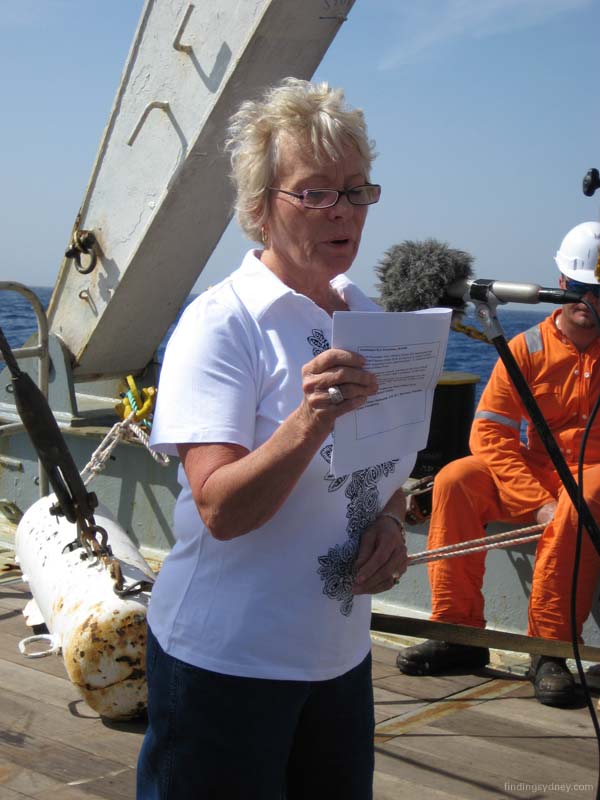
Above Photograph: Glenys McDonald reads A Sailor's Prayer.
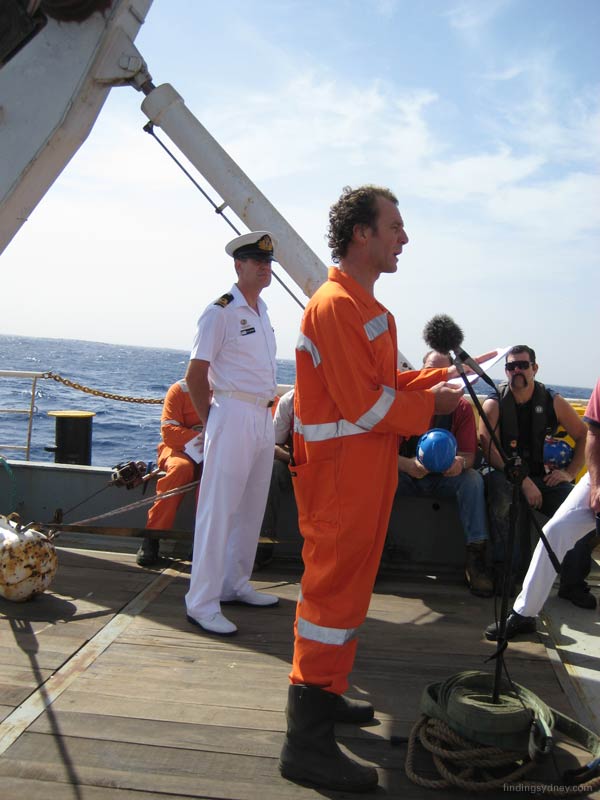
Above Photograph: Geosounder Master Blair Cliffe reads the Ode.
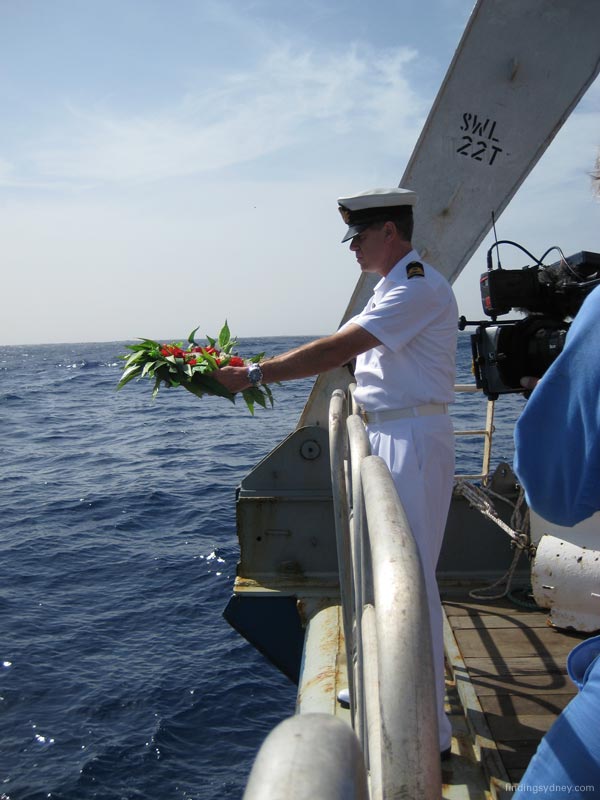
Above Photograph: Lieutenant John Perryman lays the commemorative wreath.
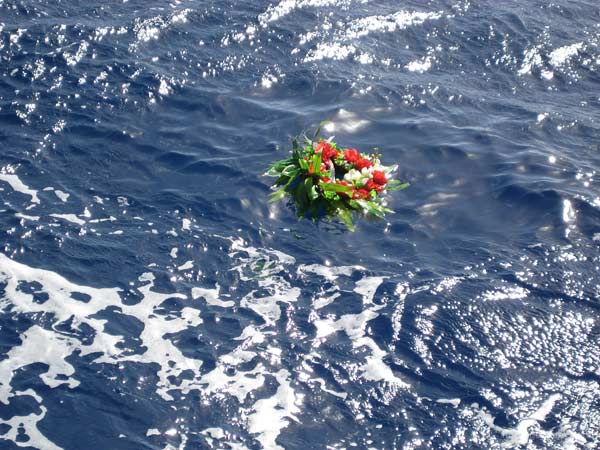
Above Photograph: The commemorative wreath drifts over the wreck of HMAS Sydney (II).
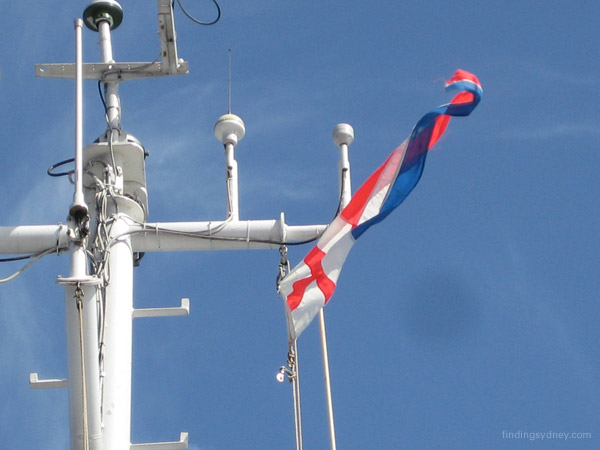
Above Photograph: The Church Pennant, symbolising that the crew is at prayer, flies from Geosounder's mast.
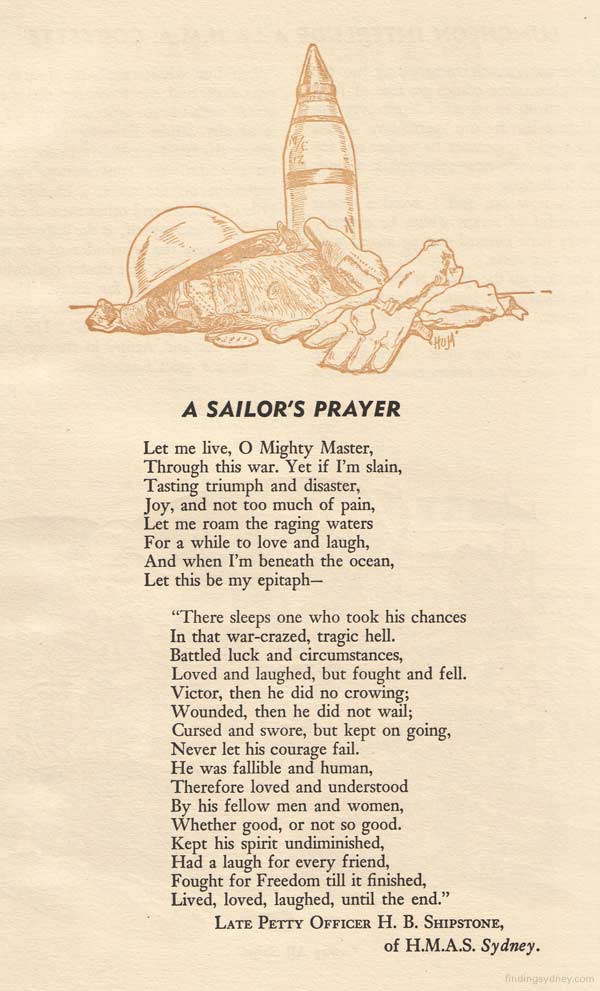
Above Photograph: A Sailor's Prayer: The text to A Sailor's Prayer.
Glenys McDonald - Director, The Finding Sydney Foundation (Observer)
I have to say that today was one I will treasure for eternity. As a Director of the Finding Sydney Foundation, and on behalf of my other directors – Chairman Ted Graham, Don Pridmore, Cdr Bob Trotter RANR, and Keith Rowe, I took part in a moving and simple, unofficial wreath laying service above HMAS Sydney.
The service was led by Lieutenant John Perryman and I had the privilege of reading a poem written by one of the lost crew of HMAS Sydney, Petty Officer H. B Shipstone, which served as an epitaph. The ode was read by the Geosounder's Master, Blair Cliffe, a former officer of the RN. John cast the wreath on the waves and we watched it float away to the sad strains of the Last Post.
Personally, standing on the heaving deck, I also realised that I was experiencing a private dream, to one day be able to say my prayers in this particular part of the ocean, a dream that has driven me on for the past sixteen years. I hope arrangements can be made to allow relatives this much needed privilege, although we are a hundred miles from the coast and the swell is anything but gentle.
We are somewhat cocooned out here on the water but the emails streaming in from relatives show us that the Finding Sydney Foundation and David Mearns achieved what they set out to do, and I have been on an emotional roller coaster since Sunday. We have now commenced the long run to Geraldton and for the first time on this search David, John and I can relax.
John Perryman - Senior Naval Historian (Observer)
Today began as the clock passed midnight in the survey room as we commenced our approach on the Kormoran wreck site with the AMS60 side scan sonar. Before long we were beginning to see the first high resolution images of Kormoran. The thing which was most noticeable to me was the distinctive shadows she cast on the sea bed. David Mearns was extremely pleased with the image and we finished our sweep of the line at 00:35. After a long and exhilarating day we were both pleased to call it a day.
Dawn on the 18th brought with it strong winds and a long Indian Ocean swell, it also brought news of an engineering defect that would affect our speed. In light of this, a decision was made to make a single pass over the wreck of Sydney using the AMS60 before recovering it and conducting a short commemorative service over her resting place. This run was conducted at 12:23 when our final image of Sydney was collected during this phase of the operation.
At 16:00, with our tow fish recovered, the crew and search team assembled on the quarterdeck of the Geosounder where I was privileged to lead a service to commemorate the men who lost their lives in Sydney. With our vessel over the site of Sydney’s wreck, the naval Church Pennant was hoisted on the starboard yardarm as a visual symbol of the solemnity of the occasion – our crew was at prayer.
The order of service involved a brief introduction by me followed by the reading of a poem entitled A Sailor’s Prayer by Finding Sydney Foundation director, Glenys McDonald. I had especially chosen this poem for the occasion as it was written by a former Sydney crewman, Petty Officer H.B. Shipstone, who now lies with his shipmates in the silent tomb which is Sydney. This was followed by the recital of The Ode read by the Geosounder’s Master, Blair Cliffe, a former Royal Navy officer. This was fitting, as many Royal Navy personnel were serving in Sydney when she was sunk. The service concluded with the laying of a wreath by me, the playing of the Last Post followed by one minute’s silence, the Rouse and Australian National Anthem.
With the service complete, we took time to reflect before shaping our course for Geraldton.
IMPORTANT NOTICE: The Material (including photographs) available in the "Press Room" section of this Website may be used/reproduced unaltered by your organisation (unless stated otherwise within the content description) subject to the terms and conditions set out in the Legal Section AND any Material (including photographs) which you use/reproduce must credit the source as "The Finding Sydney Foundation" and, as an option, you may also link the source statement with the website address http://www.findingsydney.com/.